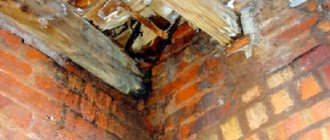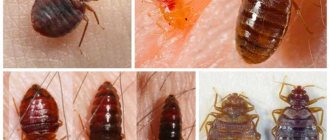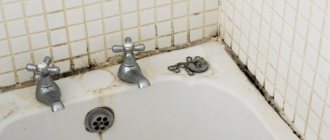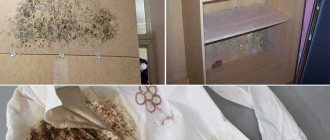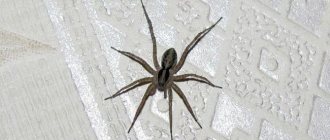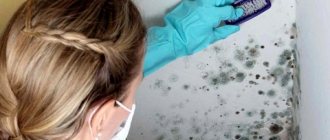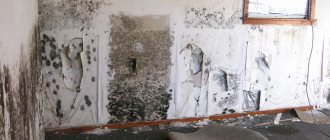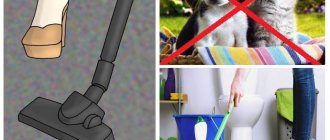Quite often mold that looks like cotton wool is found in the cellar. This is due to the fact that there is high humidity in the cellar and there is no normal ventilation. Many people do not pay attention to it, but in vain, since it can cause significant harm to human health.
In addition, there is a danger that mold can spread to food. At the same time, it is able to actively multiply, reducing the shelf life of products or making them useless. If such mold is found in the cellar, then all measures must be taken to destroy it. This article explains how to get rid of fungus correctly and quickly.
What is mold?
Mold is a type of fungus that grows in multicellular structures called hyphae. These hyphae produce mold spores that are found indoors and outdoors. Although mold spores are found everywhere, they require moisture to grow. Therefore, mildew and mold can be especially common in underground or basement areas. There are thousands of different types of mold, all of which are harmful to both the building and the person.
A few basic facts about mold:
- Mold is a fungus.
- Mold grows on concrete, wood, fabric, plaster, drywall, floors, ceilings, soil, plants and food.
- Mold produces microscopic spores that germinate where moisture has accumulated.
- Mold growth threatens the structural integrity of a building.
- Exposure to mold can lead to serious health problems.
Individual colonies of fungi and spores are very small and cannot be seen without a microscope, but once a colony of mold appears, it can form visible spots on various surfaces and locations. Mold typically comes in the following colors: black, blue or green. Its color is determined by various factors such as type, nutrient source, age of the colony, etc. Of all the types of mold, black mold (officially called Stachybotrys) is considered the most harmful to the health of living things.
The type of mold will determine the remediation method.
Mold
Various types of mold
Unfortunately, not all types are the same, but we can roughly divide them into 3 main ones:
- Allergenic – This type of mold is the least harmful of all types of mold; however, it can cause problems for people with mold allergies or asthma. Allergenic mold is usually not life-threatening.
- Pathogenic – This species is often harmful not only to people with asthma or mold allergies, but also to healthy people. For example, this type of mold can cause hypersensitivity pneumonitis, which resembles bacterial pneumonia.
- Toxigenic Mold – This type of mold can actually cause serious health problems, both temporary (eye irritation or coughing) and permanent (such as immunosuppression, neurological disorders or cancer). Toxigenic mold produces mycotoxins, a toxic chemical present within or on the surface of the mold spore that can be inhaled, ingested, or touched.
Precautionary measures
Since most anti-mold products are quite dangerous if handled carelessly, basement treatment is carried out using personal protective equipment. To do this, before starting work, put on rubber gloves, a respirator or mask, and safety glasses. Exposed parts of the body are protected with a special suit.
Solutions prepared for treatment should not be touched or inhaled. After the antifungal solution is applied to the walls and other surfaces, the room must be left and the entrance closed for several hours.
Important! Do not eat foods contaminated with mold. They will definitely be thrown out.
Why is mold dangerous and why do you need to get rid of it urgently?
So, why is mold bad and harmful? Mold growth in the basement of a private home or office building, on the ceiling, attic or cellar is dangerous for two reasons:
- First, when mold begins to grow, it feeds on the materials it grows on, causing permanent damage.
- Second, mold releases tiny spores and byproducts into the air that can be irritating or cause many illnesses. If inhaled, they can cause breathing problems.
How does mold affect your health?
Everyone's immune system and medical history are different, so it is impossible to say with certainty whether exposure to low levels of mold is safe or not, as each person will react differently.
The fact is that people with suppressed immune systems are more likely to experience health problems when they spend time indoors with mold. For example, exposure to mold growing indoors can be associated with nasal and sinus congestion, cough, sore throat, asthma (or worsening asthma), nosebleeds, headaches, skin and eye irritation, and more.
It is very important to keep in mind that some types of mold are capable of producing extremely powerful toxins called mycotoxins, which can lead to serious health effects such as cancer.
☝️ Prevention rules
Prevention is always easier than fighting. It is necessary to carry out general preventive measures, even if your cellar is dry:
- Throw away spoiled food promptly.
- Coat wooden elements with protective agents.
- Monitor the ventilation system.
- Periodically force dry the room using an electric dryer.
- Fumigate the cellar with a sulfur bomb once a season.
- Treat surfaces with a disinfectant from time to time.
Causes of mold in the basement and basement of a private house
Moisture is a key factor in the development and spread of mold in basements and homes, but it is not the only possible cause.
The main reasons for mold growth in the basement, basement and cellar:
- Excess moisture: The lack of high-quality waterproofing of the slab and basement walls from the outside leads to the fact that the material from which they are made, be it concrete, brick, FBS blocks or other types of blocks, absorbs water like a sponge, becomes wet and gives off this moisture inside the basement. This constant moisture in the walls or foundation is what leads to the emergence of various fungi and spores. In the absence or damaged waterproofing, water and moisture penetrate into concrete or brick, freeze in winter and thaw in spring, thereby destroying these substances, forming microcracks in them and expanding existing capillaries, pores and voids, which ultimately leads to increased water pressure and the formation more moisture. In addition to moisture over time, the growth of microcracks and capillaries leads to active leaks in the basement, which ultimately also affects the formation of mold.
- Condensation: Excessive condensation causes mold to form around windows, doors, cold pipes, concrete floors and walls. When these surfaces are cold and the home or building is warm, condensation forms. Areas with or near condensation are prime areas for mold growth. Lack of thermal insulation on the outside of the basement walls can lead to condensation, since in winter the heating is on in the house, and it is cold outside.
- Poor Ventilation: If the basement of a home or commercial building has poor ventilation and there is excessive moisture, this can cause moist, stagnant air to produce mold in the basement. Moisture enters the air from steam generated during cooking, cleaning and bathing. Fans and ventilation in your home dissipate moisture to prevent mold. However, when ventilation is not working, mold can grow.
How does mold grow in the basement?
Like any other living thing, mold needs water to grow. In fact, without water it cannot grow at all. Other factors that are critical to mold growth are a food source, oxygen, and an air temperature between 40 and 100 degrees Fahrenheit.
Preparing the premises
Structures located underground are constantly in a humid environment. If the space around the basement is not drained, there is no waterproofing, and the groundwater level is close to the floor surface, it is not surprising that the air in the room is saturated with water vapor.
When converting an already built cellar, it is quite difficult to carry out extensive construction work. It is necessary to dig out the basement walls around the perimeter, lay a drainage pipe, waterproof and insulate the surface, and backfill.
If this is not possible, then the walls of the basement are coated from the inside with penetrating agents - Penetron, Hydrohit. They create an impenetrable barrier in the thickness of the concrete, preventing moisture from seeping through the walls.
In practice, liquid glass and plaster with waterproofing additives are often used to protect the internal surfaces of basement walls. All joints are carefully sealed. It is important that moisture does not find even the smallest hole.
Concrete additives that prevent the development of mold - Biolin and its analogues - have a good effect. This is not yet widespread in our country, but materials can be ordered online.
It is imperative to make drainage from the roof surface, insulate the blind area and basement.
Before treating the cellar for mold, remove everything that is possible from the basement. Wash shelves, furniture and utensils with detergents or vinegar and dry for two weeks in the sun.
How to treat a basement against fungus and mold
There are several proven methods for treating surfaces and getting rid of mold and mildew.
Important: All of the treatment methods described below will temporarily rid the basement of fungus and spores, but will not be able to prevent their reappearance, since they do not solve the root of the problem and do not work to eliminate the cause of their occurrence.
Chemicals
Special chemical compounds designed to remove fungi and mold colonies are the most effective control methods. As a rule, these compounds can be purchased at any specialized store, including large chain stores that sell building materials and construction chemicals, for example, Leroy Merlin or OBI.
Important: Before using chemicals to combat mold, be sure to wear gloves, a respirator, and, if possible, a mask to protect your eyes. Do not remove mold before applying preparations (in advance)! This can disperse the spores and spread the mold to other areas where it will be more difficult to get rid of.
The best products for removing fungus and various molds:
- Savo or Savo - Savo is used to treat moldy areas on exterior and interior wood, plaster, concrete or painted surfaces. Removes mold from bathroom corners, around bathtubs and window frames. The SAVO preparation is suitable for damp rooms where there are prerequisites for the appearance of fungus. For example, in the bathroom, basements, spas, swimming pools, saunas, public baths and food warehouses. How to use: Spray the affected areas directly with undiluted SAVO from a distance of 5-10 cm. After 20 minutes, rinse the sprayed area or let it dry.
- Prosept Fungi clean – Highly effective combination of active chlorine ions as oxidizing and catalytic substances to accelerate the action of the product and get rid of spores and plaque. Prosept Fungi clean is supplied in liquid form and is suitable for application to concrete, wood, stone, brick, plastic and plasterboard. When applied, Prosept has a disinfecting effect and helps combat unpleasant odors.
- Pufas or Pufas – Can be purchased as a liquid solution or as a spray. Pufas is a reliable product for combating mold spores based on algae and bacteria. When applied, it acts immediately and has a whitening and disinfection effect.
- Neomid – Neomid material consists of a synergistic combination of biocides and processing aids. Neomid is used for treating mineral surfaces (stone, asbestos slate, tiles, concrete, brick, tile joints, etc.) in residential buildings and premises, kitchens, bathrooms, toilets, bathhouses, garages, basements, on facades and foundations. When processing with this preparation, work should be carried out in well-ventilated areas or outdoors at an ambient temperature and a temperature of the surface being treated +5°C and above.
- Cillit bang - An effective product that destroys mold without the need to scrape or clean it. CILLIT BANG POWER CLEANER BLACK MOLD REMOVER produces visible treatment results in a matter of seconds. Ideal for a variety of surfaces including concrete, plasterboard and plaster.
- Dos-spray and Bimold from the Grass company - Dos-spray Spray in a dispenser bottle with active chlorine effectively removes mold from bathtubs, sinks, toilets, pool walls, tiles, floors and other surfaces. Dos-spray and Bimold are suitable for use even in hard-to-reach places, corners, joints and joints, thanks to the simple spray formula. When processing, it is necessary to apply the product to the cleaned surface, after which it is treated with a brush or sponge. The remaining product is wiped with a microfiber cloth. For particularly stubborn stains, the treatment must be repeated by increasing the exposure time.
- Dufa Schimmel – Designed to effectively combat fungus and other spores. Suitable for use on substrates such as concrete, brick, wood, plasterboard. Dufa Schimmel contains chlorine and has antibacterial properties. For ease of use, Dufa comes in the form of a spray.
Folk methods of struggle
- Vinegar - To get rid of affected areas, apply it to problem areas using a rag or spray, repeating the procedure until the problem is completely eliminated. With proper ventilation, the acrid smell of vinegar quickly disappears.
- Soda - it must be diluted with water maintaining certain proportions (1 spoon per 0.5 liter of water). Next, the resulting solution is used to treat the problem surface until plaque and caustic substances are completely removed.
- Bleach - when diluted 1 to 10 with water, a solution is obtained with which you can fight fungal plaque and, as a result, get rid of it for a while.
Preventive recommendations
To prevent mold from becoming a permanent resident in the cellar, you need to take preventive measures:
- arrange good natural or forced ventilation;
- treat wooden structures with antiseptic impregnations;
- do not store vegetables or fruits infected with fungus;
- use quartz or bactericidal lamps;
- at the end of summer, carry out regular disinfection and ventilation.
No matter how difficult it may be, it is necessary to get rid of mold in the cellar. This will help maintain the health of family members, reduce repair costs and extend the life of the premises.
Fungal colonies and human health
Fungus can not only significantly spoil the appearance of a room, even if it is in the basement. It is very dangerous for humans. In addition, food stored underground in most households can also spoil. Mold can spread to different types of surfaces and objects. It tends to spread very quickly due to reproduction, which can greatly reduce the shelf life and usefulness of products.
These parasites affect people directly through the skin, respiratory or circulatory systems, and through the consumption of contaminated foods. After contact with this “living creature,” the following symptoms and pathologies may develop:
- dermatological skin diseases due to allergies;
- pathologies of the upper respiratory tract (nosebleeds, sinusitis, runny nose, difficulty breathing);
- headache;
- stomach upsets, problems with digesting food, nausea, vomiting;
- general exhaustion of the body, anemia.
If white mold is found in the basement, it must be removed immediately. Let's figure out how to destroy the fungus.
Read also: How is a navel piercing done in a salon?
Modern means
Dezaktin solution is one of the most effective disinfectants. After applying the solution, you need to clean up. It is carried out using a scraper or brush (metal). The fungus is scraped off from surfaces and objects.
Important! If there is rotting on the furniture, it is worth getting rid of things. Otherwise, there is a high probability of mold reoccurring.
Preparations with a high content of chlorine. These include sulfur bombs, acids and other substances.
Sulfur checker
The oldest, but no less effective way to destroy fungus in the cellar. Gas vapors spread throughout the entire infested area, which helps remove mold from the walls.
This method is prohibited for use in apartment buildings! May result in criminal liability as you are essentially spraying highly toxic carcinogens over a large area. Be careful!
Approach the matter with caution, guided by the following rules:
- Having a good ventilation system, you will need to tightly close the air shafts - old rags or foam rubber will do just fine. We carry out the same procedure with the basement exit.
- Then the checker is set on fire and remains inside for several hours (preferably from 8 to 12).
- After disinfection is completed, the room will need to be thoroughly dried and ventilated.
- Surfaces exposed to gas vapor will need to be treated with slaked lime.
- Before working with a saber, protect your respiratory organs, eyes, and skin. After setting it on fire, immediately leave the disinfection site. Smoke is POISON!
Vacuum cleaner
Regularly cleaning your basement with a HEPA (High efficiency particulate air) vacuum cleaner helps reduce the development of allergic reactions that occur due to toxins released by spores and also reduces the amount of mold.
When you vacuum with a regular vacuum cleaner, most of the spores pass through the filtration process and are released back into the air. This happens because they are too small for regular filters.
But when you vacuum with HEPA, the spores are caught in the filter and remain inside.
In addition to reducing mildew, this vacuum also removes other types of allergens.
This procedure should be carried out throughout the house, not just in the basement, at least once a week to minimize mold.

